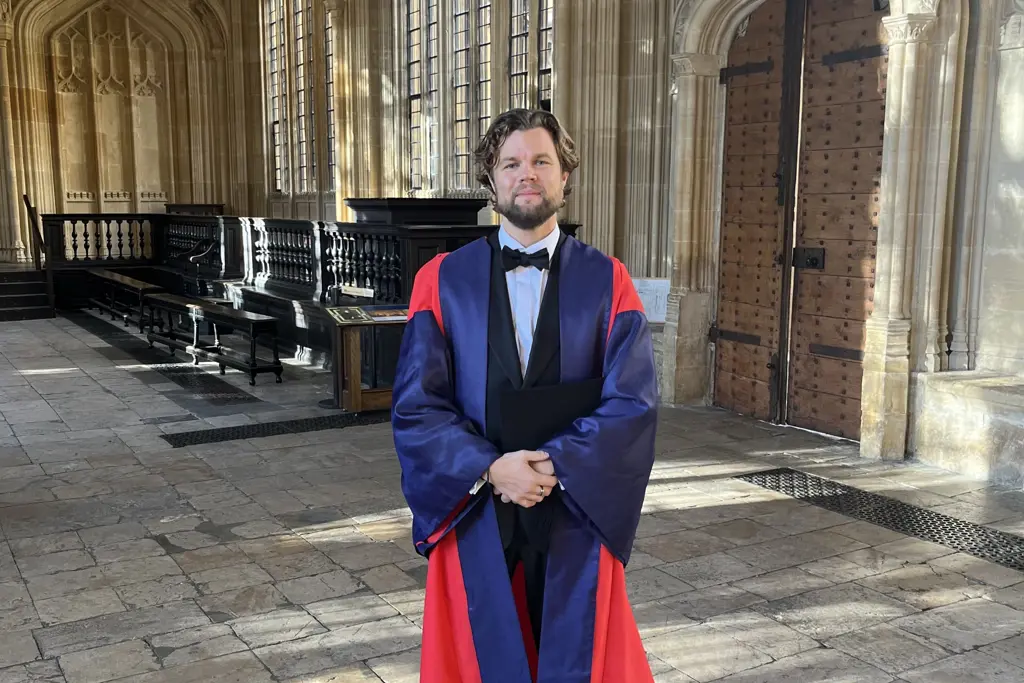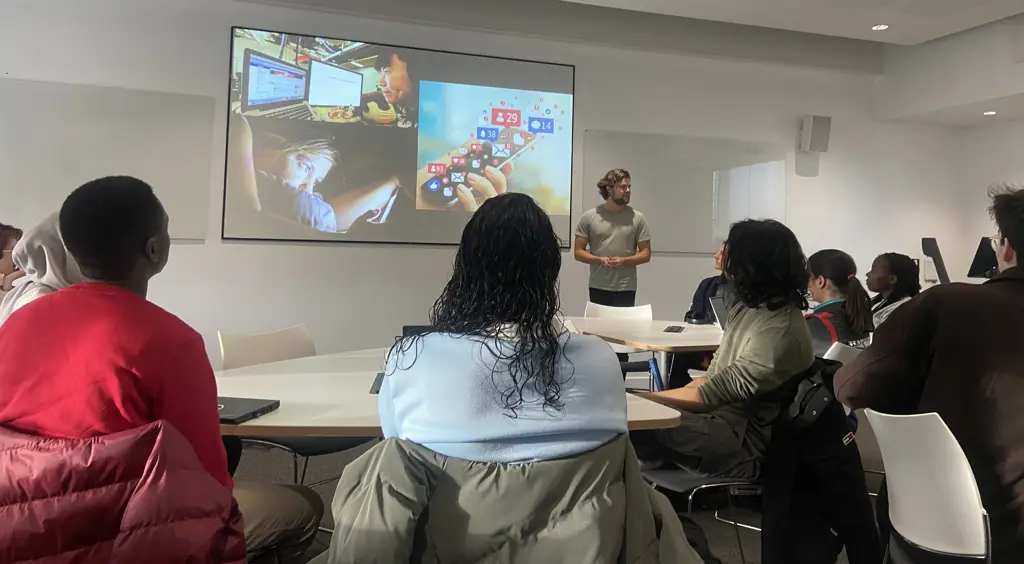
How Can We Resist the Smartphone’s Siren Song?
Is self-determination over tempting and time-consuming social media and smartphones possible? Can we reclaim our attention? Yes, says postdoc Ulrik Lyngs, who researches practical solutions to digital challenges for individuals.
Ulrik Lyngs holds out his mobile phone for closer inspection, and something is clearly different: all app icons are grey, stripped of the candy-like colors that makes the typical smartphone resemble a tempting sweet assortment.
Setting a smartphone to grayscale is just one of many simple methods to use if the phone’s siren song—promising entertainment and social media—negatively impacts your life. Perhaps you’re among the many experiencing sleep deprivation, concentration difficulties, or more due to overuse, a growing problem, especially among young people, according to several studies.
People’s challenges in managing balanced consumption of social media and apps on smartphones and computers have long fascinated Ulrik Lyngs. Since earning a master’s degree in evolutionary anthropology at the University of Oxford in 2013, he has been driven to understand what happens when technology grants us access to countless universes without physical movement.

During his Ph.D. at Oxford’s Department of Computer Science from 2016 to 2021, he explored, from an interdisciplinary perspective, how designers can optimally support people in controlling their use of digital tools—from phones to iPads. His dissertation, Odysseus in Cyberspace, drew inspiration from the Greek hero’s encounter with the seductive sirens. Odysseus had himself tied to the mast to hear their song without being lured to his doom, while his crew plugged their ears with beeswax.
But in 2025, other measures are needed when the phone’s siren song tempts us, whether through TikTok, Instagram, or games. Alarm bells are ringing about the downsides of digital life. Politicians have proposed bans on smartphones during school hours.
“It can certainly be useful to give kids the experience that the world doesn’t collapse if they don’t use their phone for eight hours. But for me, it’s fundamentally about designing digital spaces that suit our needs. We live in a highly digitized society where we want people to use tools like MitID (the mobile app that Danish citizens need to use to verify their identify when logging on to public services). If we can’t manage our attention in digital contexts, everything else fails,” says Ulrik Lyngs, Research Fellow at University of Oxford, Linacre College, and external postdoc at the University of Copenhagen’s Human-Centred Computing section.
Workshops clarify diverse digital challenges
Creating good digital spaces tailored to individual needs is easier said than done. What works for one person may not suit another.
A two-year Visiting Fellowship from the Carlsberg Foundation at Oxford (2021–23) allowed Ulrik Lyngs to explore and map the complexity of individual challenges. People have different goals for technology use, distinct personalities, and varied digital ecosystems: Android or iPhone, Windows or Mac, different browsers, and apps. These platforms offer diverse ways to curb distracting elements.

“For example, if you need to watch a specific YouTube video for a study assignment, the endless feed of recommended videos is a distraction and time-waster. When you use YouTube in a browser, you can change the design. In Chrome, you can with one click install the extension ‘Unhook’ and use it to remove recommended videos so you're able to search for what you need without distractions. But YouTube’s mobile app allow for no such control,” explains Ulrik Lyngs.
The Carlsberg-funded research project involved workshops developed with the University of Oxford Counselling Service, which supports 3,000 students annually. “They urgently needed useful guidance for the growing number of students struggling to control their use of social media and digital services, often to the detriment of their studies and mental health. Collaboration was a natural fit,” he says.
Five pilot workshops, both in-person and online, were held. Participants identified their digital distractions, clarified goals for balanced use, and chose strategies like adjusting notifications or blocking social media during work hours. Follow-ups one to three months later provided data on what worked, offering deeper insights into problems and solutions. Known as The Reduce Digital Distraction (ReDD) Workshop, the model is now available at eight UK universities.
Three Tips to Boost Your Digital Focus
- Remove distractions from necessary websites. Use tools like Newsfeed Eradicator (Chrome/Firefox) or Viking Focus (Safari) to hide e.g. YouTube’s recommended videos or Instagram’s feed.
- Block distracting websites or apps when not needed. Tools like Cold Turkey Blocker (Windows/Mac), Opal (iOS), or Stay Focused (Android) can block social media websites and apps during specific times.
- Delay opening distracting apps. Tools like one sec can prompt yourself to take a deep breath when opening apps like Instagram, encouraging intentional use.
In 2025, plans are underway to scale ReDD’s research internationally, tracking participants' progress over the course of months and years, if funding is secured. “Our initial work has clarified which strategies work for most and what’s more individual. For most, identifying and limiting digital distractions when focusing is key, instead of attempting to have superhuman self-restraint. This might mean automatically blocking TikTok from 9 to 5 on weekdays or disabling YouTube’s recommended videos,” says Ulrik Lyngs.
From Self-Control to Digital Self-Determination
There is no doubt that the challenges are numerous. And that we are constantly in a kind of arms race with many of the tech companies that control the infrastructure of apps and thus what we are able to modify as a consumer.
Initially, Lyngs used the term “digital self-control” to refer to the ability to self-regulate our use of smartphones and computers. As research has progressed, he is shifting to “digital self-determination,” to better emphasise the need to empower ourselves to actively sculpt the digital life we want.
For demanding that individuals marshall willpower in the face of limitless digital temptations is unfair. Tech companies invest heavily to capture attention for ads and data, their core business model. Blaming lack of willpower when people fail to stick to their intentended use is pointless without designing digital environments that allow a fair chance to manage attention, especially when it comess to children and learning, says Lyngs.

In 2024, he joined Denmark’s Media Council for Children & Youth, which disseminates knowledge about children and youth's use of digital media. This has sharpened his focus on classroom challenges and the need for more functional digital spaces. “Laptops could have built-in features letting teachers start a lesson by saying, ‘Let’s set our computers to math mode where only the two apps and one website we need is available.’ That would avoid putting kids in a situation where they need to spend loads of mental energy just on ignoring the constant siren song of digital distractions,” he explains.
“Designing digital environments that fit our needs is essential for a good life with smartphones, tablets, and computers. Mastering tools that enable that—from app blocking to notification settings—is the most critical digital skill for kids and adults alike.”
Science Stories is produced by Videnskab.dk for the Carlsberg Foundation.
Learn More: